How Bad is Your Spam Situation?
solutions
action
💡 Did you know? The United States is the country with the highest volume of spam emails sent daily, according to recent research on email usage in the US.
Difference Between Spam, Scam, and Phishing Emails
- Spam Emails: Unsolicited bulk messages, usually sent for advertising purposes. These emails can be annoying but are generally harmless.
- Scam Emails: Fraudulent emails designed to deceive recipients into providing money, personal information, or other valuable assets, often through false promises or threats.
- Phishing Emails: A specific type of scam email aimed at obtaining sensitive information, like usernames, passwords, and credit card details, by pretending to be a trustworthy entity.

Subscription Overload Happens Fast
Quora, Uber, Spotify, Netflix—people unsubscribe from them all the time. Clean Email shows you the full picture, so you can clean it up before it piles up—privately and in bulk.
Try It for FREEHow to Recognize Spam, Scam, and Phishing Emails
- Urgent Language: Messages that create a sense of urgency or panic, urging immediate action.
- Suspicious Subjects: Unexpected or vague subject lines, especially from unknown senders.
- Unknown Senders: Emails from unfamiliar addresses or those that seem slightly off.
- Grammar and Spelling Mistakes: Poor grammar and misspellings are common in spam and scam emails.
- Too-Good-to-Be-True Offers: Promises of large sums of money, prizes, or exclusive deals.
- Requests for Personal Information: Asking for sensitive details like passwords or financial information.
- Unfamiliar Links and Attachments: Avoid clicking links or downloading attachments from untrusted sources.
Basic Rules to Avoid Harm from Spam Emails
❌ Don’t open emails with urgent language, suspicious subjects, or unknown senders.
❌ Don’t click links or download attachments from untrusted sources.
❌ Don’t reply to spam emails to avoid confirming your address to spammers.
✅ Enable two-factor authentication to add an extra layer of security, making it harder for spammers to access your account.
✅ Regularly update passwords to strengthen account security.
✅ Educate yourself about phishing to recognize and avoid common traps.

Clean Up Old Emails While Unsubscribing
Unsubscribing is great—but what about messages already in your inbox? Clean Email can delete all past emails from the sender while unsubscribing, automatically.
Try It for FREEWhy Am I Suddenly Getting a Lot of Spam Emails?
Unfortunately, spammers frequently purchase email addresses in bulk from other companies. If you’ve suddenly noticed an increase in spam messages in your inbox, it could be because your email address is on one of these lists.
How to Safely Open a Spam Email
- Block Images in HTML Emails Before Opening: Blocking images prevents spammers from using web beacons to verify that your email address is active.
- Disable Read and Delivery Receipts Before Opening: Turning off receipts keeps spammers from knowing that you’ve viewed their email.
- Don’t Reply to Spam.
- Don’t Click Unsubscribe Links: Unsubscribe links may be harmful or confirm your address to spammers.
- Avoid Interacting with the Message Body: Don’t click on links or download attachments from spam emails.
⚠️ Whenever possible, avoid opening a spam email unless it’s already in your Spam folder.
Spam emails often “phone home” upon opening, which alerts spammers and can increase future targeting. Gmail prevents this tracking when emails are opened from the Spam folder, so it’s safer to view spam messages there (but never open attachments or click any links, including unsubscribe links).
📌 Find practical tips below for managing mild, moderate, or severe spam cases and reclaiming your inbox:
Mild Spam Situation: A Lot of Spam Emails
😤 I become overloaded with spam every 2-4 weeks.
🔧 Basic level advice
1. Train your spam filter
Most people do one of two things when they receive spam emails: they either delete them or ignore them. However, neither of these options prevents future spam messages from the same sender. So, instead, you need to report the messages as spam so your email provider learns to toss them out automatically.
How to mark junk email as spam in different email providers (any link opens in a separate window):
2. Mark spam in bulk
In case you don’t have enough time to mark every unwanted junk message manually, you can rely on the Clean Email app’s rules and filters to automate this process. The app’s Auto Clean feature can set up rules to send spam emails from the selected domain to Trash or mark them as Spam once they hit your inbox.
- Sign in to the app with your email account.
- Choose the All Mail or Inbox folder from the left sidebar.
- Click the empty checkbox next to each message group you want to select.
- Choose the Create Rule button from the action toolbar. Apply action such as Mark as Spam or any other and click Create Rule again.
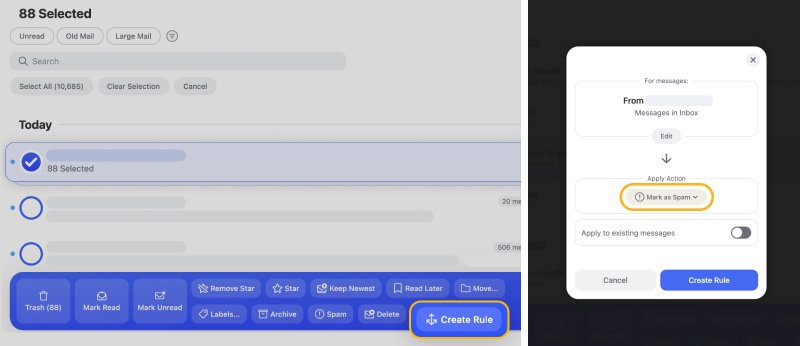

Now the rule is set and available in your Auto Clean dashboard where you can edit it when needed.
3. Block spam email senders
Sometimes marking specific messages as spam isn’t enough to prevent additional emails from that sender from ending up in your inbox. In these cases, you may want to block the sender’s address completely.
When you block a sender’s address in Gmail, any messages that come from that address will go directly into your Spam folder. To block a spam sender, follow the instructions for your email provider:
Gmail / Yahoo / Outlook (Hotmail) / Apple Mail / iCloud
4. Use Clean Email to stop getting spam emails
If you’re looking for a tool to help you maintain a clean, spam-free inbox, then you may want to try Clean Email.
Although it’s not specifically designed as a spam filter service, Clean Email does offer many great features that can help you maintain a more efficient inbox. There are several features in addition to the ones previously mentioned in this article that can help you avoid spam when you check your email.
For example, the Privacy Monitor feature can check if your email credentials were compromised during any known security break or accident. If found, you will be advised to take security measures.
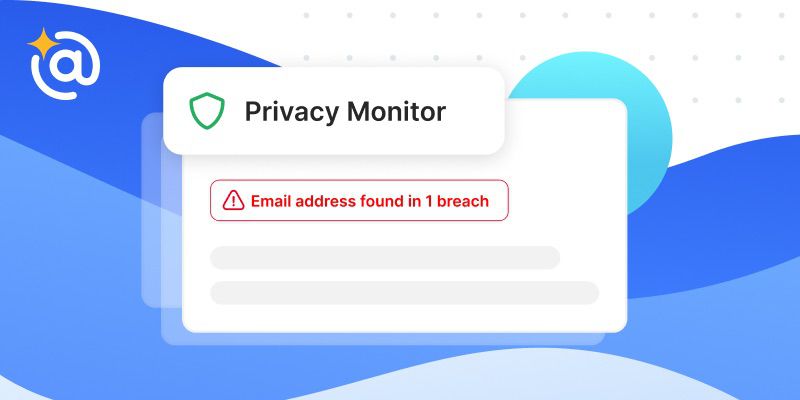
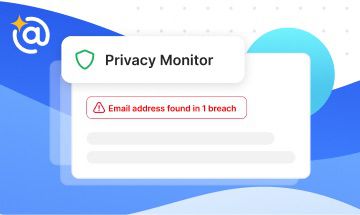
Furthermore, you can block certain addresses right from the Senders tab which is located on the left sidebar. From here, you can also pause getting messages from the selected senders or unblock the senders you’d like to remove from your blocked list.
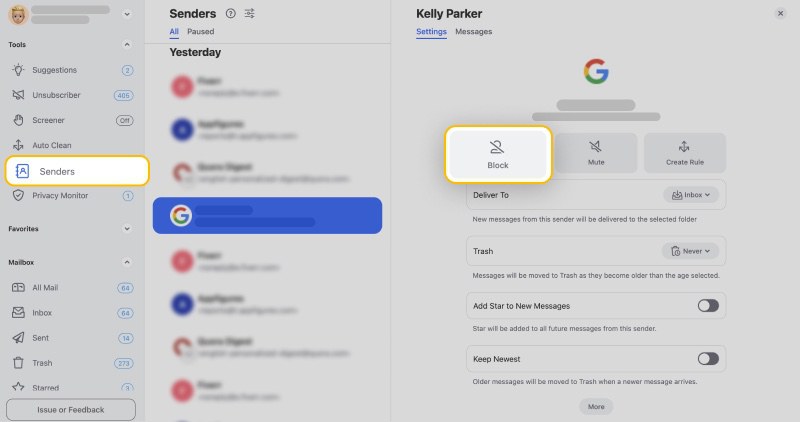
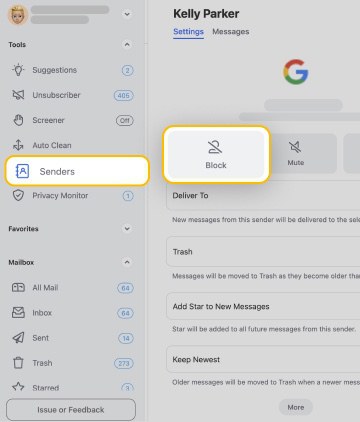
5. Block all messages from a specific domain
It’s helpful to know how to block an email address directly from your preferred email client to help you stop spam emails. In some cases, though, websites use multiple addresses from the same domain (e.g. Amazon) depending on the type of message. Unfortunately, all of these methods only block a single email address, not all messages from that domain.
However, you do have another option — you can use Clean Email to block all messages from a specific domain. To do this, simply:
- Sign in to the app on your desktop or mobile device and choose the Auto Clean tab from the left sidebar.
- Click Create Rule.
- Name the rule and click Any sender or recipients.
- In the drop-down list, choose Sender Domain. In the search box under the Sender Domain, start entering the domain you’d like to block and choose it from the items found.
- Select the action you’d like to apply to the messages from this domain, e.g. Mark them as Spam or send them to Trash.
- Click Create Rule.
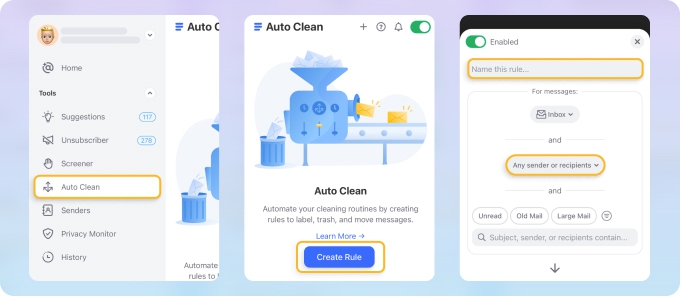
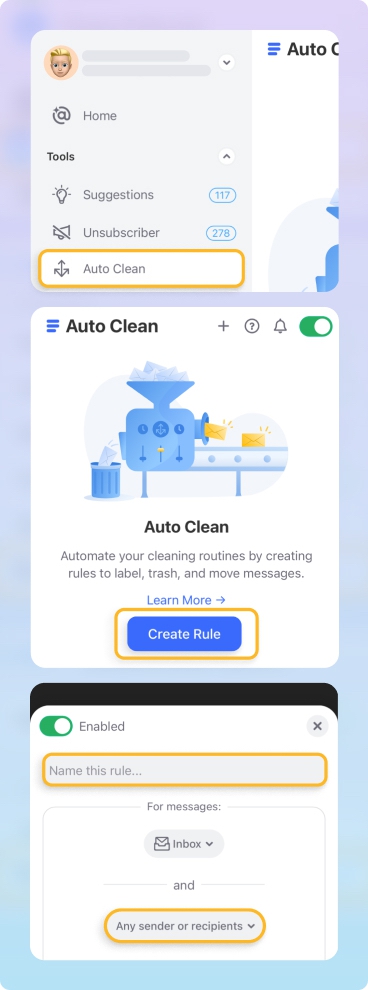
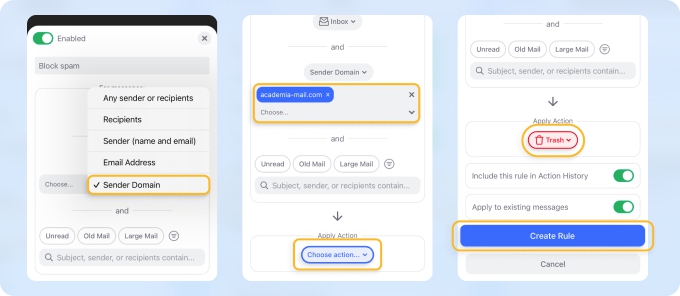
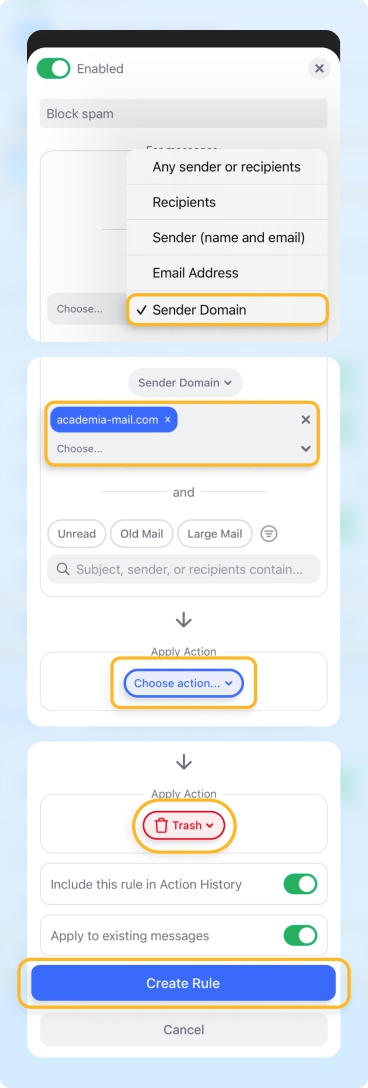
⚠️ Warning: You need to CLICK a domain found in the search results. If you only type the domain name manually, all emails from your Inbox folder may be affected.
Even if you forget about the Auto Clean rules you create, we’ll remember everything with the Action History that keeps track of all actions taken by Clean Email.

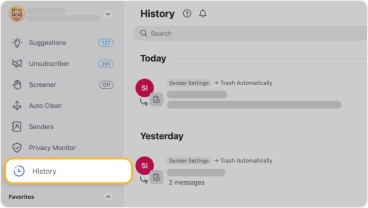
🛠️ Advanced level advice
6. Receive emails only from allowed senders
The Screener feature in Clean Email offers a powerful way to receive emails only from trusted, allowed senders. When Screener is enabled, emails from unknown senders are held in a separate review folder, allowing you to manually approve or block each new sender. This helps keep your inbox clear of unwanted messages and ensures that only relevant emails reach you.
How to enable and use Screener:
- Open the Clean Email app.
- Select Screener from the left menu and click Enable Screener.
- Toggle the I understand switch, and click Continue to activate.
- From now on, any email from a new sender will appear in the Screener folder, where you can choose to Allow or Block them.
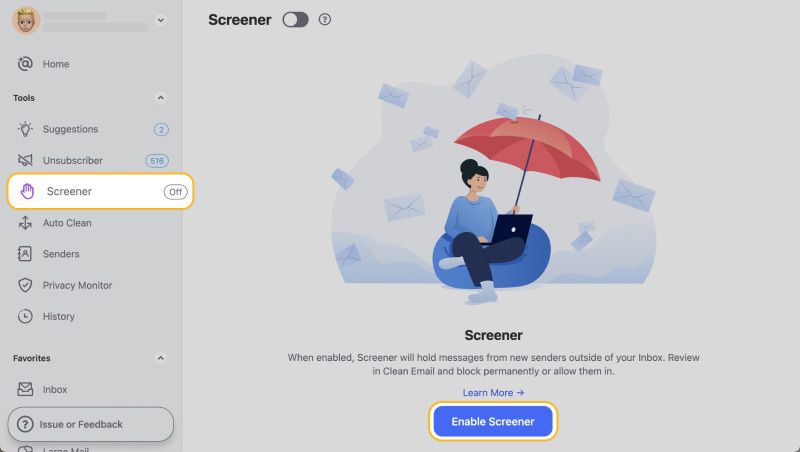
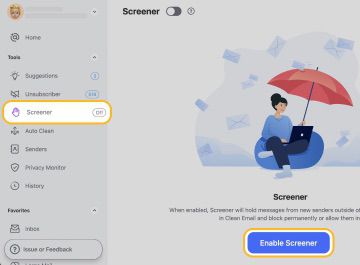
Once Screener is enabled, you can review emails from unknown senders in the Screener folder.
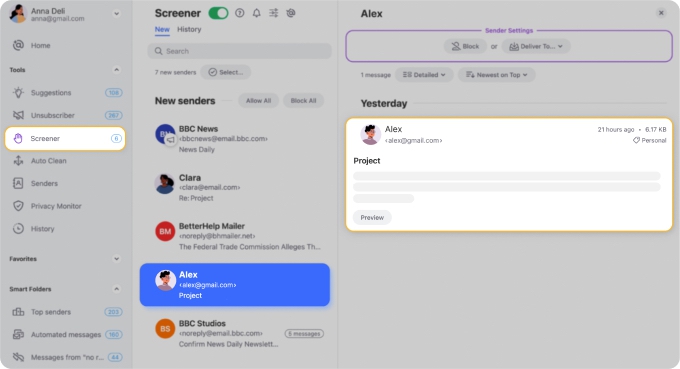
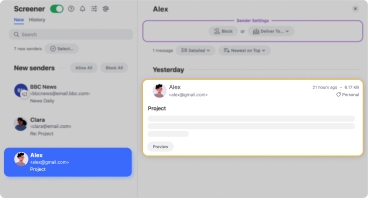
For each sender, you can choose to:
- Allow: Approve the sender, so future emails go directly to the inbox.
- Block: Prevent future emails from this sender, keeping unwanted messages out.
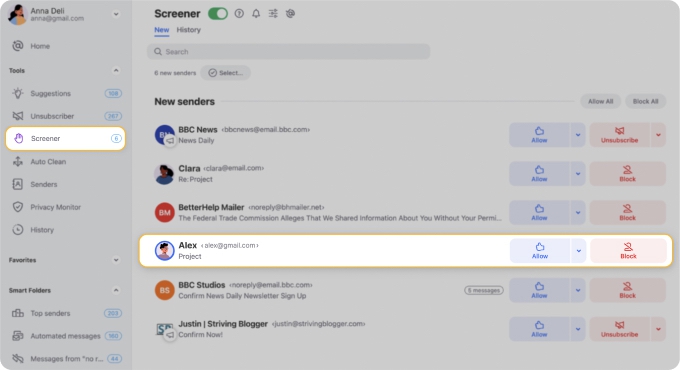
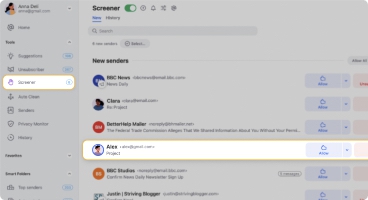
7. Monitor data breaches automatically
Clean Email’s Privacy Monitor keeps you informed about potential data breaches involving your email address.
Should Clean Email detect your email in any compromised database, an alert icon will appear next to Privacy Monitor in the navigation menu, indicating the number of potential breaches. By clicking this icon, you can review detailed insights into each breach, allowing you to take informed steps to protect your personal information.

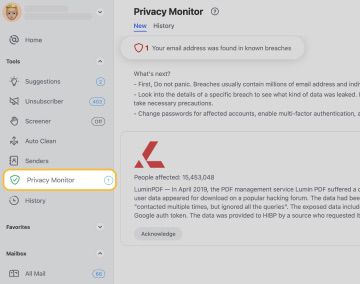
Privacy Monitor operates automatically, so you’re continuously protected without needing to enable the feature.
8. Use a third-party spam filter
Unfortunately, no email provider offers foolproof spam filtering. Luckily, there are third-party spam filter apps available to help you cut down on the amount of junk messages you receive.
Third-party spam filters are specific software applications that analyze emails before they enter your inbox to determine if they are “safe” or “suspicious.” These apps scan everything from the sender’s address to the body of the message (and more). Then, based on what it reads, the filter either allows the message to pass through to your inbox or falls into a specified junk mail location.
Although there are many of these third-party spam filters out there, not all of them work well in every situation. However, some of the best tools include apps like N-Able Mail Assure and MailWasher.
💡 We've also compiled a great list of the best email spam filter services so you can decide which third-party spam filter will meet your needs.
9. Hide your email address
If you want to stop spam emails, you should limit where you publish your email address. When you publish your email address online in a way that is publicly accessible, intelligent bots that constantly crawl the web can obtain your address. Spammers can then add your address to their database and use it to send you malicious messages or sell it to other spammers who will then flood your inbox. If you're receiving persistent messages and want to avoid AT&T sams emails or similar marketing outreach, limiting public exposure of your email is essential. In fact, this is most often how email spammers get your address.
If possible, use contact forms instead of publishing your email address publicly on personal or professional websites. If using a contact form isn’t possible or you must post your email address somewhere for any reason, try to obfuscate it as much as possible. Instead of writing my@email.com, write my (at) email (dot) com. You won’t fool all bots, but it’s still better than nothing.
Additionally, you may want to check your email security settings and look for ways to increase the privacy of your email address. Measures like encrypting emails, using strong email passwords, and enabling two-factor authentication will help you secure your inbox. Furthermore, you may want to check what third-party apps have access to your inbox and review which devices have access to your inbox to avoid hacking attempts.
If you specifically use Apple devices, you can also take advantage of Hide My Email. This unique tool lets users create random email addresses for certain apps and websites so that your primary email address is never given out. You can easily enable this feature by going to iPhone Settings → iCloud → Hide My Email.
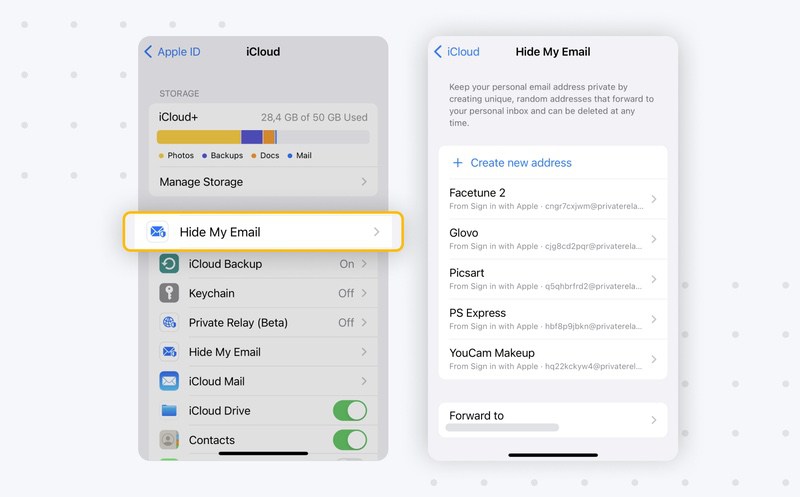

Then, any time you log into a site or app using your Apple ID, it will hide your email address for you automatically.

People Unsubscribe from More Than Promos
Stats show users often drop security alerts, digests, and recaps—not just marketing ads. Clean Email lets you securely manage all types of email, not just obvious spam.
Try It for FREEModerate Spam Situation: Too Many Unwanted Emails
😬 I’m overloaded with mixed emails, like Spam, Social, Promotions, etc.
🔧 Basic level advice
1. Watch out for check boxes that are already selected
When shopping online, be cautious of pre-selected check boxes that allow companies to share your email address with third parties.
Always uncheck these boxes to prevent your email from being distributed to other businesses, which can help reduce unwanted spam in your inbox.
🛠️ Advanced level advice
2. Clean unwanted messages quickly
The Cleaning Suggestions feature in Clean Email makes it easy to clear out unwanted emails. This tool continuously learns from user interactions, identifying the most effective actions for each type of email, such as social updates, promotions, or newsletters.
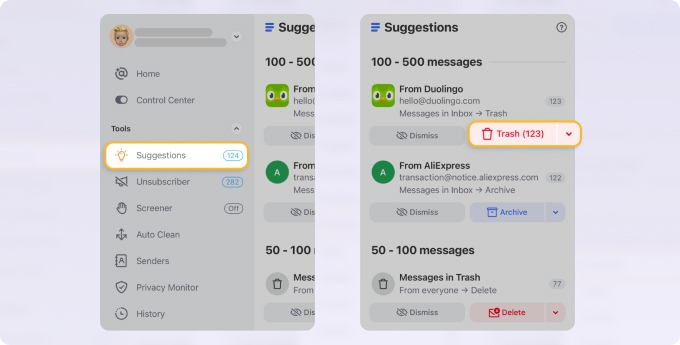
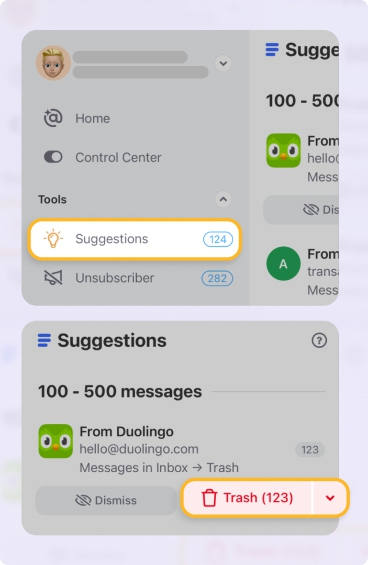
Based on these insights, Cleaning Suggestions offers specific recommendations, like bulk-deleting or archiving messages, to help you keep your inbox tidy. By following these quick suggestions, you can efficiently manage clutter without needing to manually sort through emails, saving time and improving inbox organization.
3. Unsubscribing from mailing lists
There are many instances where you receive spam messages because you somehow signed up for a mailing list. This often happens when you purchase a product from an online vendor or enter your email address on a website to receive a coupon code. Unfortunately, these messages can quickly overtake your mailbox, especially if the company sends messages daily or, even worse, multiple times per day.
If you need to learn how to unsubscribe from unwanted emails, we recommend using the Unsubscribe button that most email providers now offer at the top of email messages that the client picks up as possible spam. In fact, Gmail, Apple Mail, and Outlook all offer these automated tools.
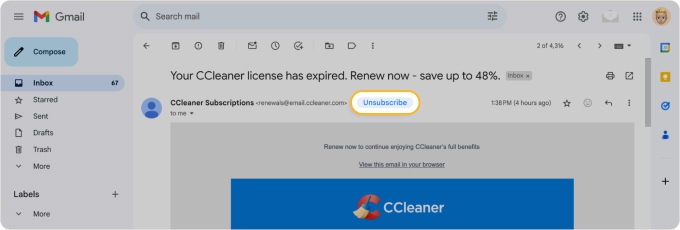
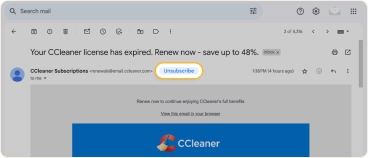
If you open an email and the Unsubscribe button doesn’t appear in the top toolbar, you can still unsubscribe from within the message:
- Most companies include an unsubscribe link at the bottom of marketing emails.
- Alternatively, open an email from the sender you wish to unsubscribe from, use your web browser’s search function, and look for “unsubscribe” to quickly locate the link within the message.
- If there’s no unsubscribe option in the message, check your email provider’s settings for options to unsubscribe or block the sender.
💡 If neither of these methods works, or if you simply don’t have the time to go through this process for marketing messages from multiple companies, you can use the bulk unsubscribing tool, Clean Email. It will help you even if you’re unsure how to stop spam emails through other methods.
When you log into Clean Email, you can select the Unsubscriber tool from the main menu.

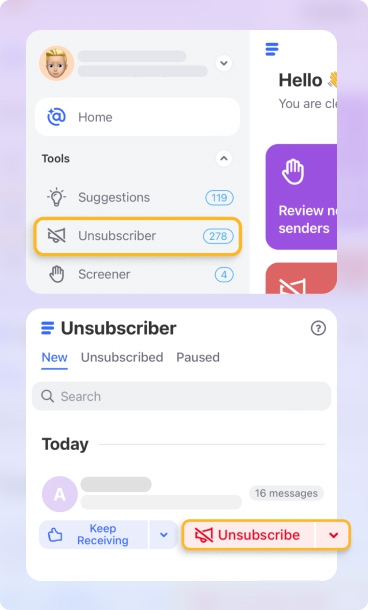
Within this tool, you can see all your subscriptions and can easily select multiple newsletters you no longer need.
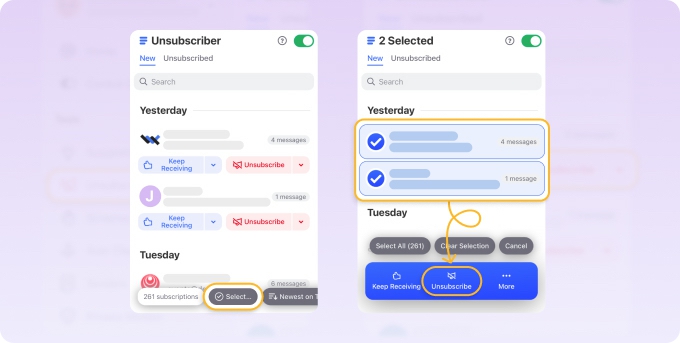
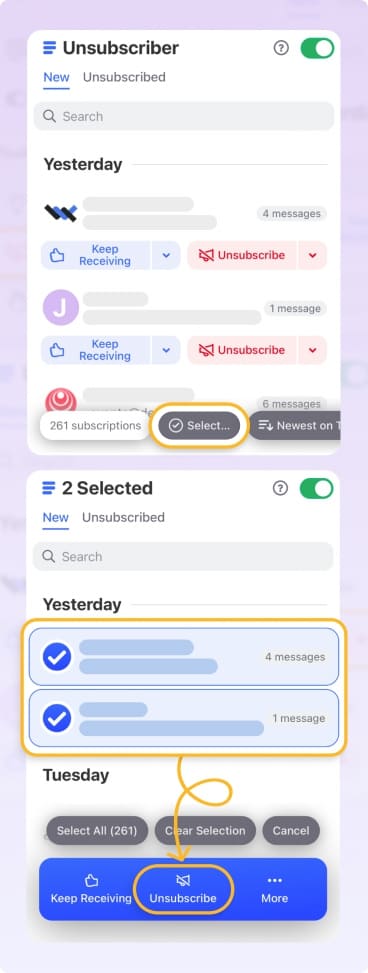
When you push Unsubscribe, Clean Email will follow the required steps to remove your email address from the selected mailing list. The app will send unsubscribe requests and complete unsubscribe forms to opt you out. Until the sender completely unsubscribes you, all new messages will be sent to Trash directly so you never see them again in your Inbox.
4. Automate your email cleaning
And again, with Clean Email's Auto Clean feature, you can keep your inbox organized automatically, preventing spam and clutter from building up over time.
📌 Jump up to learn how to block all messages from a specific domain.
Auto Clean lets you create rules that instantly manage unwanted messages as they arrive, sending them to Trash, marking them as read, or even moving them to specific folders. This feature saves time and keeps your mailbox tidy without constant manual intervention.
How to use Auto Clean:
- Sign in to Clean Email on your desktop or mobile device for easy access on the go.
- Select All Mail or Inbox, or any other folder from the left sidebar.
- Tap the checkbox next to each group of emails you’d like to manage.
- Then choose Create Rule or More → Create rule in the action toolbar.
- Apply an action, like Move to Trash or Mark as Read, and confirm by clicking Create Rule again.
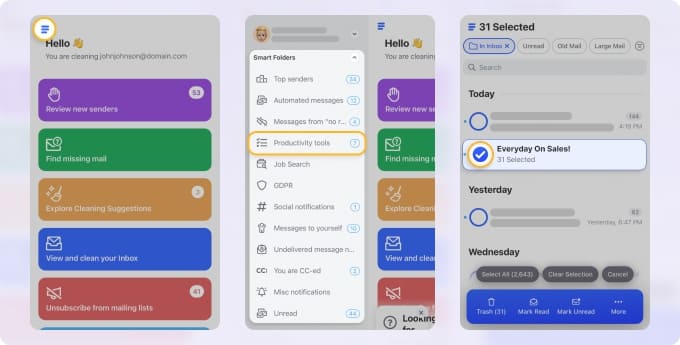
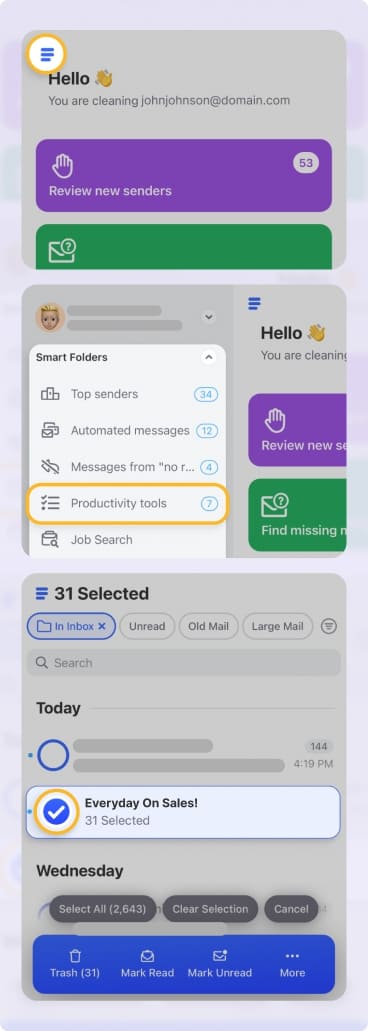
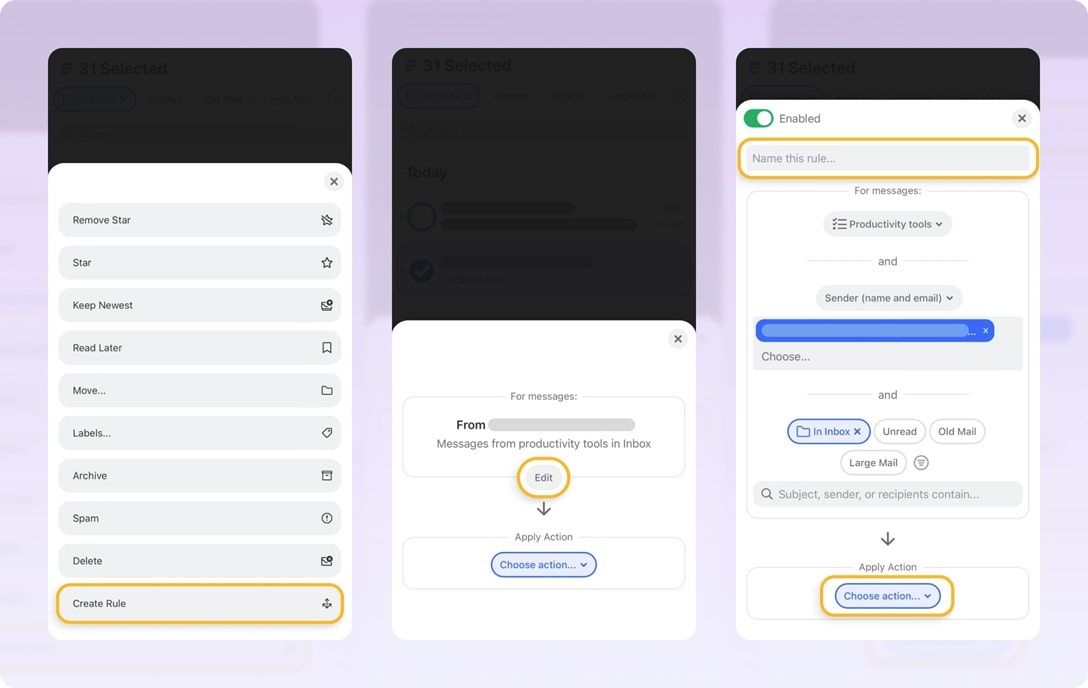

Your Auto Clean rules will now work in the background to keep your inbox clutter-free, and you can view and adjust them anytime from the Auto Clean dashboard—right from your iOS or Android mobile device.
Severe Situation: A Massive Spam Attack
😵💫 I need to clean spam every day. A bunch of spam emails comes every 5-30 minutes!
1. Only accept emails from known senders
Arguably the most effective way to stop unwanted junk email is to only accept emails from known senders. However, not all email services will let you do this easily.
So, let’s take a brief look at how to create safe contact lists and train spam filters in each of the major email providers: Gmail, Yahoo, Outlook, Apple Mail client, or any other. In most of them you need to find a profile icon of the sender, then click on an additional menu(three dots) and click on a button about adding this address to the contact list.
💡 Read our full guide on how to whitelist an email so these emails will arrive in your inbox and never get marked as spam.
2. Use Screener to keep unknown senders quarantined
As discussed above, another way to keep your inbox protected from unknown senders is to use the Screener feature by Clean Email. With the Screener enabled, you can stop spam emails as all messages from new senders will be kept away from your Inbox.
You can easily review them in the Screener tab on the left sidebar and choose which emails you want to allow to be delivered and which of them should be blocked and deleted.
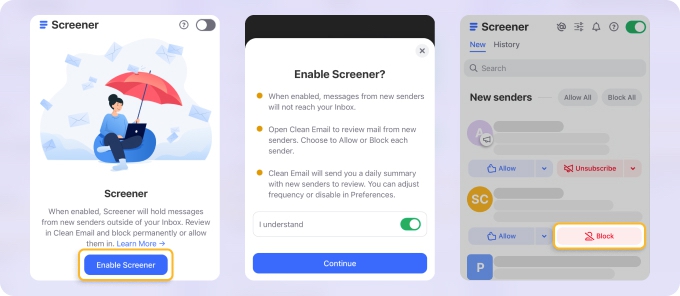

3. Use alternative email addresses
It’s a good idea to have multiple email addresses and use each for a different purpose. Reserve your main email address only for work, family, and friends and have at least one more email address ready for online shopping, entertainment, and other purposes.
It’s also handy to have a junk email address that you can use whenever a shady website wants you to register. If worst comes to worst and that shady website turns out to be a source of spam emails, you can just create a new junk email address and forget about the old one.
Today, there’s no shortage of excellent email services that provide gigabytes of free email storage space. Gmail is by far the most popular option, but there’s also Outlook.com, Yahoo Mail, Zoho Mail, AOL Mail, Yandex, and others.
Keep in mind that not all email services are equally resistant to spam emails. If one of your inboxes starts overflowing with spam messages for no apparent reason, we recommend you consider leaving it for one of the most secure email providers to help you avoid additional spam.
4. Change your email address
If none of the above suggestions work, it may be time to move on and simply change your email address. Then use the suggestions above to keep the new address from becoming filled with spam. All you need to do is create a new email address with your favorite email client, then forward any important emails to the new address.
However, consider where you may need to change this address (like with credit card companies or other vendors who send you paperless statements) and make sure you take the needed measures to update these addresses.
How to Stop Spam Emails - FAQs
Will spam emails eventually stop?
Spam emails will likely always be an issue we all deal with. However, if you block spam senders and take other recommended steps to secure your inbox, you can cut down the amount of spam emails you receive.
Can I block spam emails?
Yes, there are measures you can take to block spam senders with your email provider and through third-party apps like Clean Email.
How to stop spam emails on iPhone?
If you use Apple Mail or a similar email client, you can flag senders to cut down on the amount of junk mail you receive.
How do I stop spam emails permanently?
You can take several steps to help stop spam emails or messages from specific senders from landing in your inbox. These steps include unsubscribing, training your spam filter, and blocking emails from specific senders.
How do I stop spam emails in Gmail?
Gmail offers several tools to help you stop spam emails from getting to your inbox, several of which we've outlined in this article.


